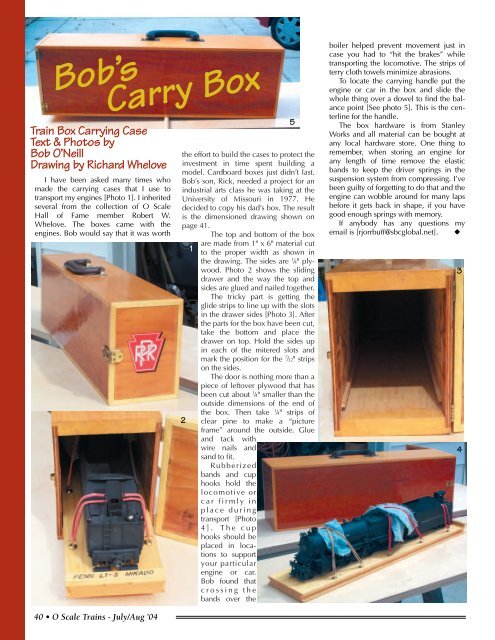Scale - O Scale Trains Magazine Online
Scale - O Scale Trains Magazine Online
Scale - O Scale Trains Magazine Online
You also want an ePaper? Increase the reach of your titles
YUMPU automatically turns print PDFs into web optimized ePapers that Google loves.
Bob’sTrain Box Carrying CaseText & Photos byBob O’NeillDrawing by Richard WheloveI have been asked many times whomade the carrying cases that I use totransport my engines [Photo 1]. I inheritedseveral from the collection of O <strong>Scale</strong>Hall of Fame member Robert W.Whelove. The boxes came with theengines. Bob would say that it was worthCarry Box5the effort to build the cases to protect theinvestment in time spent building amodel. Cardboard boxes just didn’t last.Bob’s son, Rick, needed a project for anindustrial arts class he was taking at theUniversity of Missouri in 1977. Hedecided to copy his dad’s box. The resultis the dimensioned drawing shown onpage 41.The top and bottom of the boxare made from 1" x 6" material cut1 to the proper width as shown inthe drawing. The sides are 1 ⁄4" plywood.Photo 2 shows the slidingdrawer and the way the top andsides are glued and nailed together.The tricky part is getting theglide strips to line up with the slotsin the drawer sides [Photo 3]. Afterthe parts for the box have been cut,take the bottom and place thedrawer on top. Hold the sides upin each of the mitered slots andmark the position for the 7 ⁄32" stripson the sides.The door is nothing more than apiece of leftover plywood that hasbeen cut about 1 ⁄4" smaller than theoutside dimensions of the end ofthe box. Then take 1 ⁄4" strips of2 clear pine to make a “pictureframe” around the outside. Glueand tack withwire nails andsand to fit.Rubberizedbands and cuphooks hold thelocomotive orcar firmly inplace duringtransport [Photo4]. The cuphooks should beplaced in locationsto supportyour particularengine or car.Bob found thatcrossing thebands over theboiler helped prevent movement just incase you had to “hit the brakes” whiletransporting the locomotive. The strips ofterry cloth towels minimize abrasions.To locate the carrying handle put theengine or car in the box and slide thewhole thing over a dowel to find the balancepoint [See photo 5]. This is the centerlinefor the handle.The box hardware is from StanleyWorks and all material can be bought atany local hardware store. One thing toremember, when storing an engine forany length of time remove the elasticbands to keep the driver springs in thesuspension system from compressing. I’vebeen guilty of forgetting to do that and theengine can wobble around for many lapsbefore it gets back in shape, if you havegood enough springs with memory.If anybody has any questions myemail is [rjorrbuff@sbcglobal.net]. ◆3440 • O <strong>Scale</strong> <strong>Trains</strong> - July/Aug ’04
















